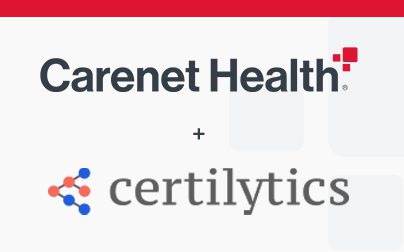
Critical Challenges Ahead for Medicare Advantage Plans
Healthcare payers currently face multiple financial challenges with Medicare Advantage plans. A recent boost in post-pandemic patient confidence and reimbursement changes are creating significant hurdles for many payers. So, protecting revenue has become a high priority.
Carenet Health® offers a suite of services that tap into the rise of healthcare consumerism to help payers maintain profitability and strengthen their financial foundation and future. These are tools that support the business of healthcare through insightful consultation, technological innovation and personalization that boosts the customer experience.
Post-COVID Medicare Advantage-Payer Landscape
Health services utilization has lagged for several years due to continuing fear and discomfort from the COVID-19 pandemic. But now, an increasing number of Medicare Advantage beneficiaries are headed back to the doctor for routine appointments or to the hospital for elective procedures. This uptick in inpatient and outpatient utilization is substantial. And, as many organizations terminate their Medicare Advantage contracts, major commercial payers that are responsible for covering these visits and procedures are feeling financial pressure.
In April, the Center for Medicare & Medicaid Services (CMS) added another layer of financial concern when it levied a cap on Medicare Advantage payments for the coming year. Rather than the anticipated 4.7% increase, the agency revealed reimbursements will only rise by an average of 3.7%. The reimbursement raise is even smaller when adjusted for costs and inflation.
Between the tidal wave of medical costs and smaller payment rates, payers now feel the pinch. Many are panicking amid double-digit stock price tumbles and benefit-expense ratios hovering between 85-90%.
The Path to Recovery
Fortunately, the road to financial recovery for many payers exists. However, the path may be winding in an environment where patients expect more choices and control over their healthcare decisions. In fact, 45% of consumers research plans before choosing one, and 44% do the same before choosing a specific provider.
But attempting to reduce medical spending and secure optimal reimbursement alone is a tall task for any payer. Instead, payers can benefit from collaborating with an experienced partner that has expertise in both navigating all facets of Medicare Advantage and working directly with members, says John Erwin, chief executive officer of healthcare support service, care management and consumer engagement company Carenet Health.
“We offer a very compelling solution set that helps payers preserve as much revenue as possible. Our goal is to help lower their medical spend and help them operate as efficiently as possible,” he says. “We are armed with perspective from over 500 premier healthcare partners, and we are primed to assist with cutting the cost of care and maximizing administrative savings.”
The Carenet Health Strategy
Overall, Erwin says, Carenet can leverage its Intelligent Engagement™ model to address payers’ financial needs through standardized engagement strategies that directly reach members. These tactics focus on membership growth and satisfaction, star ratings and risk adjustment, and cost control and spending.
Membership acquisition and retention:
Attracting and acquiring new members is vital. In fact, retaining members for the first two years is critical for customers. Targeted marketing efforts can help organizations educate potential members about coverage options, benefits, premiums, deductibles, co-payments and networks. These efforts work best when individuals have multiple channels for accessing information and receiving assistance.
Payers can use these same avenues to introduce renewal activities as members approach the end of a coverage period. These efforts can include incentives, personalized plan recommendation and plan selection guidance. The end result is two-fold: coverage renewal and long-term, loyal member relationships.
Strengthening membership:
Welcome calls, onboarding initiatives and enrollment in wellness programs can help members feel comfortable with a new plan. Carenet’s advanced customer relations management platform also contributes to a personalized healthcare experience and leads to better coordinated care and improved outcomes.
Star ratings and risk adjustment:
Star ratings are more vital than ever as members are becoming more discerning with their healthcare dollars. Carenet’s CX Analytics Group has more than 15 years’ experience gathering details from over 200 different healthcare areas, including patient experiences and insights. This information helps payers design care plans that best fit their clients’ needs.
In addition to star rating improvement efforts, Carenet also provides health risk assessment (HRA) support. For example, its HRA evaluation questionnaire helps payers identify any gaps in patient engagement so they target their efforts to each member’s individual needs. This tool can also assist payers in finding the best avenues to improve communication with members such as text messages, emails or phone calls.
HEDIS® Scores:
HEDIS® improvement initiatives can also boost plan performance. Carenet’s year-long strategy directly engages members to identify gaps in care that need to be addressed. The company promotes member activity through plain-language resources that explain the importance of preventive health services. And it can help payers create engagement teams to identify members’ barriers to care. By embracing telehealth and meeting members where they are via multichannel outreach strategies, HEDIS improvement programs can positively impact members choices and activities.
Cost control and spending:
Reigning in medical spending is paramount to each payer’s financial survival. Carenet can help payers with this reduction in five ways:
- Collaborations with providers: Carenet’s Shared Decision Making solution encourages patients to collaborate with providers to choose the best treatment options. By using analytics, health coaching and decision aids patients and their providers can make the most informed decisions about a range of conditions. The ultimate result can be improved patient satisfaction and a reduction in the cost of care.
- Lower emergency department (ED) utilization: Members have easy access to care with Carenet’s Virtual Clinic, 24/7 Nurse Advice Line and Behavioral Health crisis support. By introducing the Virtual Clinic, some payers have seen a 67% drop in costs, and the Behavior Health crisis support helps 95% of patients avoid an ED visit. In addition, remote patient monitoring and health coaching can help reduce ED utilization.
- Reduced hospital stays: Carenet’s clinical support teams also complete early and frequent follow-up patients upon hospital discharge. By identifying and intervening as soon as possible with any complications, these healthcare providers can lower member costs and improve outcomes.
- Fewer readmissions: Better transitions of care can help members avoid costly hospital readmissions. To limit these expenses for payers, Carenet can proactively schedule patients who have a referral from their primary care provider to see a specialist. Streamlining the scheduling process boosts adherence and improves outcomes and patient satisfaction. It also ensures greater continuity of care.
- Steerage via providers: Patients who stay in-network for the health services incur lower costs. Carenet educates primary care providers on how to best refer patients to in-network hospitals and specialists.
Ultimately, Carenet has the expertise and tools to promote healthcare consumerism among members and help payers navigate these uncertain Medicare Advantage waters.
“Our solutions can help payers overcome these market challenges,” he says. “We are uniquely positioned to offer support at this moment healthcare.”
Want to learn more? Talk to an expert now.



